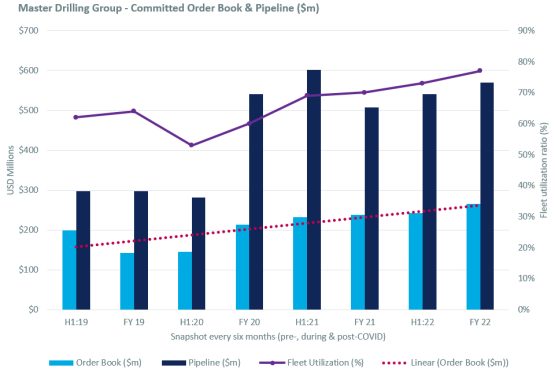A little over a year ago, I wrote about how I expected Master Drilling Master Drilling Group (MDI) to report strong results.
This wasn’t anything clever from my side. Rather it was noting that the group’s key variables were moving in its favour: its order book (a leading indicator for future revenue) was growing strongly and utilisation rates on its fleet (a leading indicator for future margins) was rising strongly.
If your future revenue is likely to be higher and your future margins are likely to be better, your future profits are likely to grow strongly.
Read:
Little surprise then that last week Master Drilling reported strong results for the year to 31 December 2022:
- USD revenues grew 32% year on year;
- USD headline earnings per share (Heps) grew 10% and Heps in rands grew even more (16%); and
- While cash generation was a bit weak (working capital came through late and should reflect in the group’s estimates for the coming financial year), the group hiked its dividend by a whopping 46%.
And its ‘key variables’ as noted above?
Not only have the committed order book, pipeline and utilisation rates recovered quickly from the first half its 2020 financial year (January to June 2020) – the period of hard Covid-19 lockdowns around the world – but they are currently higher than the group’s pre-Covid levels (and with little sign of slowly down).
Source: The author
Much like before, this implies good forward results are likely to be reported.
That said, I will caution that practicalities around the fleet dictate that utilisation rates will probably never reach 100%. Jobs finish and rigs need to be moved, dropping their utilisation to below 100%. Thus, utilisation is likely toppish in these results and, at best, should remain flat.
But when capacity and availability of rigs is the bottleneck, Master Drilling can start to push the pricing of the rigs.
If the mines need to compete among themselves for drilling services, the owner of the fleet wins.
This ‘pricing’ lever (Master Drilling calls it ARPOR or ‘average monthly revenue per operating rig’) is another variable that we are only just starting to see play out this cycle. It may have a larger impact going forward at these toppish utilisation rates.
Despite all of this, Master Drilling’s share price has only recovered back to more or less the same as its pre-Covid levels.
In fact, we must compare like with like, and Master Drilling’s order book and pipeline are reported in US dollars. Thus we should look at its share price in USD rather than rands.

Source: The author
Terrifyingly, despite rand deprecation against the USD (moving from R13-odd to the USD to its current R17 to R18 to the USD) and its USD-based order book, pipeline and utilisations all moving higher than pre-Covid levels, Master Drilling’s share price remains flat.
Everything is shooting the lights out at Master Drilling, except the share price.
At a price-earnings ratio of 5.9 times, paying dividends, and with a nearly ungeared balance sheet and global cutting-edge dominance in an increasingly important service as resources get scarcer and deeper underground, Master Drilling remains an arguably undervalued global gem hidden away on the JSE.
Listen to Fifi Peters’s interview with Master Drilling CEO Danie Pretorius about the group’s latest full-year results:
You can also listen to this podcast on iono.fm here.
Keith McLachlan is chief investment officer at Integral Asset Management.
* Keith McLachlan and some of Integral Asset Management’s portfolios may hold Master Drilling shares.

